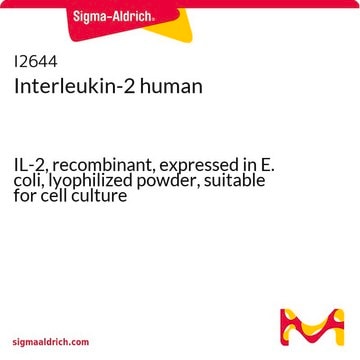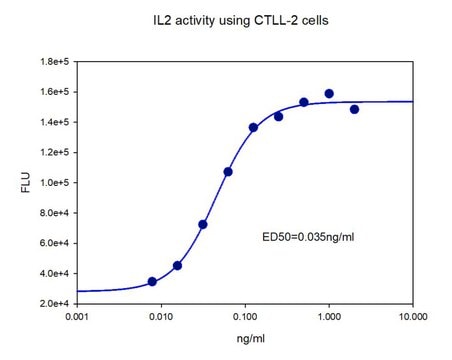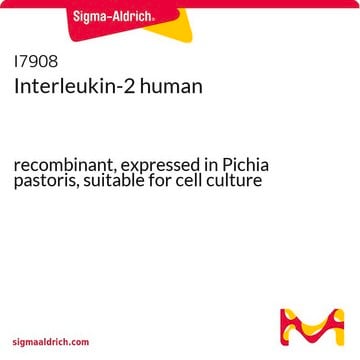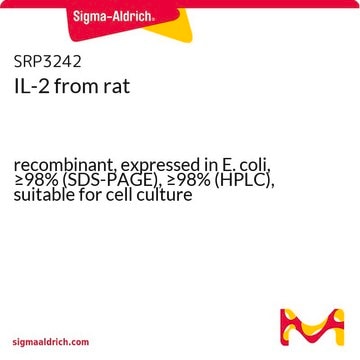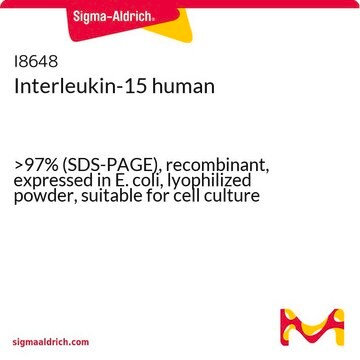HIL2-RO
Roche
Interleukin-2, human (hIL-2)
recombinant (E. coli)
Sign Into View Organizational & Contract Pricing
All Photos(1)
About This Item
UNSPSC Code:
12352202
Recommended Products
biological source
human
Quality Level
recombinant
expressed in E. coli
Assay
95% (SDS-PAGE)
form
solution
potency
>2 x 10^6 units/mg EC50
mol wt
(15,000 Da)
packaging
pkg of 10,000 U (10799068001 [5 μg, 50 ml])
pkg of 10,000 U (11011456001 [5 μg, 1 ml])
pkg of 50,000 U (11147528001 [25 μg, 5 ml])
manufacturer/tradename
Roche
storage condition
avoid repeated freeze/thaw cycles
concentration
10-20U/ml
impurities
<0.1 EU/μg
UniProt accession no.
storage temp.
−20°C
Gene Information
human ... IL2(3558)
General description
Recombinant Interleukin-2, human (hIL-2) is produced in E. coli and purified by standard chromatographic techniques. Solution in PBS and 1 mg/ml BSA, filtered through a 0.2 μm pore size membrane.
Specificity
Species specificity: Recombinant IL-2, human is effective on mouse and human cells.
Application
Recombinant IL-2, human, allows:
- The cultivation of human and murine IL-2 dependent T-cell lines and natural killer cell lines.
- The proliferation of mitogen-activated T-lymphocytes and natural killer cells.
- The establishment of human and murine thymocyte, splenocyte, or peripheral blood lymphocyte (PBL) derived T-cell lines.
- The generation of human and murine lymphokine-activated killer (LAK) cells (1-11).
- In vitro re-stimulation of lung cells obtained from mice.
Biochem/physiol Actions
Interlekin-2 (IL-2) is a potent pro-inflammatory cytokine. It plays a protective role in autoimmune chronic inflammation, when present in low amounts. It is involved in maintaining immune homeostasis where it controls the cross-talk between T regulatory and T effector cells. Studies in acute myelogenous leukemia (AML) mice models show that antibody based delivery of IL-2 to targets present in tumor-linked vasculature results in antileukemic activity.
Quality
Purity: >95% pure as determined by SDS-PAGE
Endotoxin level: <0.1 EU/μg (LAL-test), <10 EU/ml (LAL-test)
(1 EU corresponds to 0.1 ng)
Endotoxin level: <0.1 EU/μg (LAL-test), <10 EU/ml (LAL-test)
(1 EU corresponds to 0.1 ng)
Sequence
Chain Length 134 AA
The primary structure of recombinant, IL-2, human is identical to that of natural, human IL-2 (one polypeptide chain, 133 amino acids), however, recombinant IL-2 has an extra methionine at the amino-terminus (one polypeptide chain, 134 amino acids) and is not glycosylated. Glycosylation is not essential for biological activity.
Unit Definition
EC50 definition: The amount of hIL-2 that is required to support half-maximal stimulation of cell proliferation (XTT cleavage) with CTLL-2 cells (1 unit equals ≤0.5 ng).
Unit Conversion: 1 BM unit = 3.25 NBSB units (natural IL-2)
Unit Conversion: 1 BM unit = 3.25 NBSB units (natural IL-2)
Physical form
Solution in PBS and 1 mg/ml BSA, filtered through a 0.2 μm pore size membrane
Preparation Note
Working concentration: 10 -20 U/ml
Established IL-2-dependent T-cell lines usually require 10-20 U/ml. Add IL-2 to the freezing medium for IL-2 dependent cell lines.
Working solution: Dilute the concentrated IL-2 solution (200 U/ml or 10,000 U/ml) with PBS or culture medium containing 1 mg/ml BSA or HSA (0.1%) or 1 to 10% serum.
Storage conditions (working solution): -15 to -25 °C
It is recommended to store the solution in aliquots at -15 to -25 °C.
Note: Avoid repeated freezing and thawing.
Specific activity/EC 50 : >2 x 106 U/mg <0.5 ng/ml (hIL-2, NIBSC, 1st international standard, 86/504), at least the same specific activity (EC50 ) compared to the indicated standard is guaranteed (19, 20). Human, recombinant IL-2 has the same biological activity in vitro as compared to human, natural IL-2 (15, 1–4).
Recommended Method of Dilution: Dilute the concentrated IL-2 solution (200 U/ml or 10,000 U/ml) with PBS or culture medium containing 1 mg/ml BSA or HSA (0.1%) or 1–10% serum.
Interleukin-2 (IL-2, also known as T-Cell Growth Factor, TCGF) is a lymphokine which is produced by lectin- or antigen-activated T-cells and plays an important immunoregulatory role. This factor, or lymphokine, was first identified by its ability to promote the long-term in vitro proliferation of activated T cells. It also promotes the generation and proliferation of cytotoxic T-cells, natural killer (NK) cells, and lymphokine- activated killer (LAK) cells (1–11). Recombinant human IL-2 allows the cultivation of human and murine IL-2-dependent T-cell lines and natural killer cell lines, the proliferation of mitogenactivated T-lymphocytes and natural killer cells, the establishment of human and murine thymocyte-, splenocyte-, or peripheral blood lymphocyte (PBL)- derived T-cell lines, and the generation of human and murine lymphokine-activated killer (LAK) cells (1-11). Established IL-2-dependant T-cell lines usually require 10-20 U/ml. Add IL-2 to the freezing medium for IL-2 dependant cell lines.
Established IL-2-dependent T-cell lines usually require 10-20 U/ml. Add IL-2 to the freezing medium for IL-2 dependent cell lines.
Working solution: Dilute the concentrated IL-2 solution (200 U/ml or 10,000 U/ml) with PBS or culture medium containing 1 mg/ml BSA or HSA (0.1%) or 1 to 10% serum.
Storage conditions (working solution): -15 to -25 °C
It is recommended to store the solution in aliquots at -15 to -25 °C.
Note: Avoid repeated freezing and thawing.
Specific activity/EC 50 : >2 x 106 U/mg <0.5 ng/ml (hIL-2, NIBSC, 1st international standard, 86/504), at least the same specific activity (EC50 ) compared to the indicated standard is guaranteed (19, 20). Human, recombinant IL-2 has the same biological activity in vitro as compared to human, natural IL-2 (15, 1–4).
Recommended Method of Dilution: Dilute the concentrated IL-2 solution (200 U/ml or 10,000 U/ml) with PBS or culture medium containing 1 mg/ml BSA or HSA (0.1%) or 1–10% serum.
Interleukin-2 (IL-2, also known as T-Cell Growth Factor, TCGF) is a lymphokine which is produced by lectin- or antigen-activated T-cells and plays an important immunoregulatory role. This factor, or lymphokine, was first identified by its ability to promote the long-term in vitro proliferation of activated T cells. It also promotes the generation and proliferation of cytotoxic T-cells, natural killer (NK) cells, and lymphokine- activated killer (LAK) cells (1–11). Recombinant human IL-2 allows the cultivation of human and murine IL-2-dependent T-cell lines and natural killer cell lines, the proliferation of mitogenactivated T-lymphocytes and natural killer cells, the establishment of human and murine thymocyte-, splenocyte-, or peripheral blood lymphocyte (PBL)- derived T-cell lines, and the generation of human and murine lymphokine-activated killer (LAK) cells (1-11). Established IL-2-dependant T-cell lines usually require 10-20 U/ml. Add IL-2 to the freezing medium for IL-2 dependant cell lines.
Other Notes
For life science research only. Not for use in diagnostic procedures.
also commonly purchased with this product
Product No.
Description
Pricing
Storage Class Code
12 - Non Combustible Liquids
WGK
nwg
Flash Point(F)
No data available
Flash Point(C)
No data available
Choose from one of the most recent versions:
Already Own This Product?
Find documentation for the products that you have recently purchased in the Document Library.
Customers Also Viewed
Christoph Schliemann et al.
Cancer immunology research, 3(5), 547-556 (2015-02-13)
The antibody-based delivery of IL2 to extracellular targets expressed in the easily accessible tumor-associated vasculature has shown potent antileukemic activity in xenograft and immunocompetent murine models of acute myelogenous leukemia (AML), especially in combination with cytarabine. Here, we report our
Elisa Lupino et al.
Immunology, 131(2), 231-241 (2010-05-15)
Stimulation of naïve CD4(+) T cells through engagement of the T-cell receptor (TCR) and the CD28 co-receptor initiates cell proliferation which critically depends on interleukin (IL)-2 secretion and subsequent autocrine signalling via the IL-2 receptor. However, several studies indicate that
Marcel A Schijf et al.
Journal of virology, 86(21), 11472-11482 (2012-08-17)
Breast feeding reduces the risk of developing severe respiratory syncytial virus (RSV) infections in infants. In addition to maternal antibodies, other immune-modulating factors in human milk contribute to this protection. Specific dietary prebiotic oligosaccharides, similar to oligosaccharides present in human
Beibei Wu et al.
eLife, 10 (2021-12-16)
CRAC channel regulator 2 A (CRACR2A) is a large Rab GTPase that is expressed abundantly in T cells and acts as a signal transmitter between T cell receptor stimulation and activation of the Ca2+-NFAT and JNK-AP1 pathways. CRACR2A has been
Agata Kosmaczewska
International journal of molecular sciences, 15(10), 18574-18592 (2014-10-17)
For many years, the role of interleukin-2 (IL-2) in autoimmune responses was established as a cytokine possessing strong pro-inflammatory activity. Studies of the past few years have changed our knowledge on IL-2 in autoimmune chronic inflammation, suggesting its protective role
Our team of scientists has experience in all areas of research including Life Science, Material Science, Chemical Synthesis, Chromatography, Analytical and many others.
Contact Technical Service